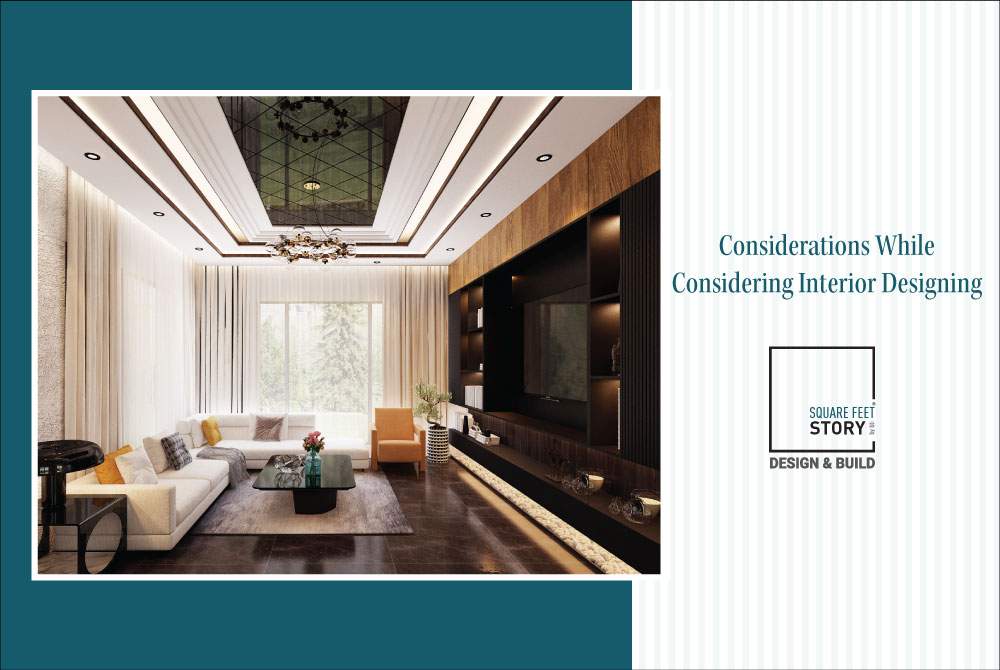
Considerations While Considering Interior Designing
Interior design is a culmination of balance, rhythm, emphasis, proportion, and harmony of a space. The desired end result is achieved when all the design elements and principles interrelate and work together to enhance the visual appeal of a space. Balance, proportion, and rhythm bring the elements of color, pattern, texture, and shape into a functional relationship with the physical aspects of space, light and structure. The space around an object is affected by the shape and size of the object. How pieces relate to each other has to do with the pieces themselves and the space around them. To make things look balanced and interesting, sometimes it is not the proportion of one object, but rather how the objects relate to others in the entire space which results in a balanced and interesting setting.
Of course, DIY-ing the interior design of a space keeping the above in mind may become an overwhelming task for you. An innovative solution is to find the right designing partner or firm, such as Square Feet Story, who will handle your project on par with the right designing approach and what you have envisioned for your space. However, whether you go for expert help or decide to DIY, here are some important things you need to consider when you plan:
Set Your Budget
Whatever the scale of your budget is, it is important to figure this part out first. This will define the parameters of what you can or cannot do. Research is crucial because you do not want to waste any resources. Address your goal of transforming the space- is it for yourself or for guests? Get the help of interior designers of your choice, or browse design websites or magazines to find out the answers to your questions. Collect various images, fabric swatches, floor samples, paint colors, etc. This will assist you in landing on the design style you truly love, aligned with your budget.
Transformation Goal
Ask yourself- what are you seeking from this space? Define the goal of this space and the functionalities that will affect your daily life. You have to have a clear comparison between what you want and what is needed. Every space has priorities and circumstances that act as design axes. If it is a bedroom interior then you need to focus on what kind of ambiance you want, what furniture will work, and besides sleeping what other functionalities it will serve you. Similarly, for a living room, you need to consider what will be the central focus of this space, which theme are you looking for, and what pieces can define the style you want to achieve. In interior designing, ‘winging it’ is a risky and wasteful approach.
Transformation Time
The estimated time of interior design completion is very important. You need to plan this out in detail. As you cannot use the space during the transformation process you need to make arrangements such as storage, privacy, safety measures, etc. Factor in the possibility of revisions and delays in order to have a realistic expectation. Keep in mind that the time you set will dictate the manpower required, the range of designs you can opt for, as well as the materials you can use.
Aesthetics: Expected Vs. Actual
There can be major or minor differences between the expected and actual transformation of a space’s interior. It is good to keep this in mind. Due to many reasons, it may not exactly be like the Pinterest reference you set as your benchmark. Availability of resources and craftsmanship play a major role in this. Your structure and environment may also dictate slight discourses of the design. Realistic expectations will result in giving you a satisfactory result that you will enjoy in the long run. However, when you choose an experienced firm for your projects, they will discuss all these with you prior to work commencement and also be able to meet your design requirements as closely as possible.
Color, Free Space & Theme
Of all the crucial things in interior designing, color is the most essential one. It is a common story for homeowners to fall in love with a particular shade only to despise it after the transformation is completed. Hence, swatching the desired shade along with some options or trying out 3D Visualization is strongly suggested. Once your space is transformed, you will have to live with it for a while. Similarly, the importance of free space cannot be stressed enough. You need breathing space in every room for movement or relaxation. Overstuffed rooms, no matter how lavishly done, can become tiring in the long run. This is why choosing a theme helps. Your theme can direct your color and spatial choices, allowing you to make an informed decision you will be happy with.
Ambiance
If you forget about ambiance during your space transformation planning then you will miss out on that extra magic that inspired you to decorate in the first place. Lighting makes or breaks the ambiance of a space. You want neither gloom nor glare in your rooms. What you want is clever lighting to create the right ambiance and accent the beauty of your layout and décor. Do not forget to factor in the purpose of the space while deciding this.
Hopefully, the points discussed above have been helpful with your interior designing plans. It is strongly recommended to seek expert help for the optimal transformation of your space. The hunt for the perfectly designed space is a culmination of science and art. If you can swing it then more win for you! However, we urge you to take a quick peek at Square Feet Story and our social media pages. Come, see what we do and how we can aid you in achieving the magical transformation of your space.


